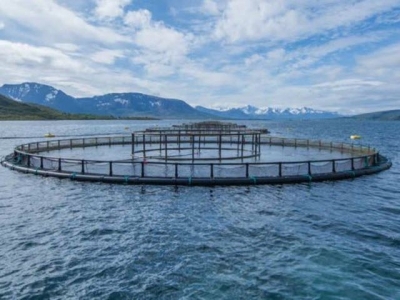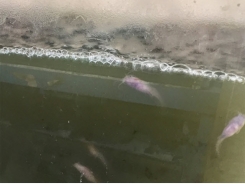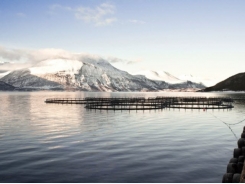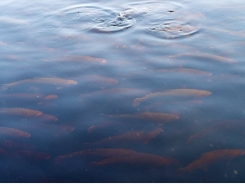What does the salmon net pen of the future look like?

The past few years have seen first a leap in offshore farming developments, spearheaded by Norway's development licenses, and then a greater move by land-based aquaculture practitioners than had been seen before.
Photo: Salmon net pens. Credit: AKVA Group
However, both of these are in the development stages; it's likely the long-term future of offshore farming will feature an amalgamation of those designs currently being tested, while – despite some optimism now – it remains to be seen if land-based aquaculture for the full growout cycle will be financially viable.
In the near-to-mid-term, it seems likely that salmon farming will continue to be chiefly based in the coastal areas it has traditionally inhabited.
Trond Davidsen, president of the International Salmon Farmers Association, said as much earlier in 2018, noting that while closed-containment and recirculating aquaculture systems had parts to play, the most "climate-friendly" method at present was land-based post smolt production, raising juvenile salmon larger in biosecure facilities, before putting them to sea in open cages.
But that's not to say these cages will resemble those that were put to sea a decade or more ago; or even those we have now. There are numerous "aquatech" companies, established and startups, looking to make improvements to the classic net-pen formula.
What does the salmon farm of the future look like?
The net pen
The basic set-up of a coastal net-pen has been pretty well refined at this stage, and innovations or improvements are likely to be small.
Norway's AKVA group is one of the biggest – if not the largest – aquaculture equipment suppliers in the world. It produces both plastic and steel cages; roughly 45,000 of the former, and 15,000 of the latter, since its inception, it estimates.
Its key brand of plastic cage is the 'Polarcirkel', new designs of which are generally intended to lower the weight-to-strength ratio. It's a similar story with its steel cage, 'Wavemaster' brand.
On the netting front, traditional fiber nets, mainly nylon, are the most-used. However, AKVA describes its own “EcoNets” as “innovative and promising”. Made from strong, light plastic, its producer – Maccaferri – claims it is “virtually escape-proof and predator-proof”, and has a lifespan of 20 years, compared to nylon nets which last between four and six.
“EcoNet has a very hard surface that resists marine fouling and makes it easy to clean in the water. Due to the very low water drag resistance, [it] also ensures maximum water flow to the fish," the company said.
"This has resulted in some of the best ever production results in large scale salmon farming, such as higher SGR [specific growth rate], lower FCR [feed conversion ratio], lower mortality and higher fish harvest quality.”
Spring cleaning
If your pen nets do still require cleaning, AKVA offers a remote-control “flying net cleaner”, which runs on thrusters rather than wheels to minimize the chances of damage to the nets while running.
However, if having to operate your net cleaner yourself would take up valuable time, perhaps Remora, developed by Norwegian firm Mithal, might be of interest.
This autonomous device lives in the pen and automatically cleans nets on a daily basis, with no extra strain on human resources. It uses brushes rather than pressurized water, to lessen the risk of net damage, and as an added bonus, inspects and maps the net and any faults that might be developing too.
Remora is backed by Innovasjon Norge, and counts Marine Harvest among those who are interested in trialing it. It is currently still at the prototype stage.
"Marine Harvest have expressed that the promises we have given them on the functionality will be a game changer if indeed we can perform (which we think is perfectly possible)," Mithal founder Leiv Midthassel told Undercurrent News.
UPDATE: Johan Sol of Dutch firm Seatools told Undercurrent it too has piece of cleaning technology under development; its remotely operated mort collector, or Romoc. "We have successfully finalized a first feasibility and conceptual design study, and now we are developing the technology further," he said.
The highly-automated mort collection system was designed for large-scale offshore fish farms in particular. It can cover the entire pen surface within 24 hours, meaning a healthy fish farm environment that prevents disease transmission, the firm claims.
Helping hands
On the topic of autonomous helpers which live under water, the company behind the “Eelume” concept is eyeing an entry to aquaculture for its subsea inspection, maintenance and repair robot.
Presenting at the North Atlantic Seafood Forum in March 2018, Eelume CEO Arne Kjorsvik said he saw the fish farming sector as the next step for the technology, after the oil and gas sector.
The aim in the future is to have the Eelume “live” in a subsea docking station, venturing out for inspections and routine jobs on a regular basis, without requiring any human inputs.
It's a modular concept, with propulsion, sensor and dexterous arm and “hand” pieces, which should be able to carry out tasks suited to the maintenance of salmon pens.
That all-important question of lice
There are also physical additions to the net pen that can be made, or may be possible in the near future, designed to improve salmon health.
One “futuristic”-seeming device which has been around for some years, and is now quite widely used, is the optical delouser produced by Stingray Marine Solutions.
The in-pen technology that shoots sea lice with lasers is now used in some 200 pens across Norway, and that is not its only use, said CEO John Arne Breivik at NASF.
Since the beginning of the firm’s development it has intended to utilize the in-pen units for more than just killing sea lice. Counting lice is a requirement for Norwegian farmers, and the 200-odd units can take more than 1 billion photos each day, he claimed.
Another unit providing a similar function is the SpectraLice, produced by Norwegian firm Ecotone. This, according to the company, is the first fully automatic sea lice counter.
Currently on trial with farmers Leroy Seafood Group, Marine Harvest and Masoval Fiskeoppdrett, SpectraLice is due for a full pilot trial from spring 2018 onwards, and a commercial launch in 2019.
Presenting at NASF, the firm's representative claimed it was “destined to take a large part of the Norwegian market”. It holds a patent to use its “hyperspectral imaging technology” underwater in 15 countries, and is seeking NOK 20 million in investment to help it towards its commercial launch.

Ecotone CEO Ivar Erdal told Undercurrent pilot contracts are in the process of being closed at present.
Also soon to be competing in this field is Fishency Innovation's SmartFunnel. Another Norwegian creation, SmartFunnel aims to reduce man-hours devoted to lice counting, and to provide information to farmers not currently available in their fight to manage the pest.
In the summer of 2017 Fishency received financial backing from Innovasjon Norway, and in the fall it took part in a mentoring program in Stavanger, taking a three month residence in the “iPark tech startup accelerator'.
It received NOK 1m funding from RFFVest for a pilot project, and has welcomed Norway Royal Salmon executive Stein Ove Tveiten as a “pilot partner”. In-cage tests were carried out in November 2017.
Of course, what's better than automatic counting of sea lice? Not having any sea lice to count. That's the goal for startup Blue Lice, which aims to switch focus from treatment to prevention.
With funding from the Norwegian Seafood Research Fund, and in cooperation with the Norwegian Institute for Natural Science and farmer Bremnes Seashore, Blue Lice has developed a unit which attracts, captures and contains sea lice before they latch onto salmon.
It has a patent pending for the solution, and during the spring of 2018 is looking to start commercial production of its unit, to be sold via a distribution partner; on its website it quotes Ola Hausken of AKVA as saying “if you have a good solution for sea lice prevention, we are interested in cooperating with you to get it to the market”.
Or, for (presumably) a much lower investment, salmon pens of the future may contain “wrasse hotels”; plastic units in which lice-eating wrasse are much happier, and which maker Estro claims helps them live much longer alongside the salmon.
Presenting at NASF, the firm said it had secured funding, and believes it can achieve a sales target of NOK 600m eventually.
Dutch firm H2O Technics believes it has a revolutionary solution for fighting algae which may build up in salmon pens and harm the fish, as well as lice.
Its underwater resonators produce more than 40,000 vibrations per second, which in turn cause “nano cavitation”. This, essentially, means bubbles are produced which, when they burst, create microscopic water jets, eliminating the cells of parasites and algae seeds.
“As far as is known, H2O Technics is the only company in the world supplying this type of product, which justifies it being referred to as revolutionary,” the firm said.
Time for precision
One feature which looks highly likely to be integral to salmon farming in the near future is “precision farming”. Several of the technologies mentioned above and several which are probably already in use contribute to data gathering and allow for a much better understanding of how to best raise salmon.
Norwegian firm BioSort’s “iFarm” concept which has been trialed by salmon farmer Cermaq Group should provide the data to boost efficiency across the entire aquaculture sector, said CEO Geir Stang Hauge.
The sorting and scanning unit which sits between the lower part of the cage and the surface, so that salmon must move through it to fill their swim bladders can identify each salmon as individual by its skin patterns.
Thus it can monitor growth, scan for disease or sea lice occurrences, and so on.
The unit is then able to sort the salmon, siphoning off only those requiring treatment through pipes, ensuring the fish remain un-stressed and in the water at all times.
It can sort them for treatment, or by weight for harvesting. The scanning unit keeps salmon lower in the water in the first place, avoiding many of the sea lice which tend to move nearer the surface. “We can gather data for thousands and thousands of individuals, and that will build a picture which can help the whole industry make gains in efficiency,” said Hauge.
This level of data management will feed into software programs such as Optimeering Aqua's “BioPlan” or AKVA's “Fishtalk”; the former believes there is a NOK 7bn improvement to be made globally by salmon farmers, just by harvesting precisely what is needed, when it is needed.
At NASF the company also offered its services on a test basis, for free, in a bid to show the industry it could improve margins by NOK 2m per concession with its planning software.
This is, of course, not an exhaustive list of "aquatech" innovations. If you know of one Undercurrent should look into, please contact the author here.
Related news
Tools

Phối trộn thức ăn chăn nuôi

Pha dung dịch thủy canh

Định mức cho tôm ăn

Phối trộn phân bón NPK

Xác định tỷ lệ tôm sống

Chuyển đổi đơn vị phân bón

Xác định công suất sục khí

Chuyển đổi đơn vị tôm

Tính diện tích nhà kính

Tính thể tích ao




 Developments in closed-containment technologies for salmonids, part 1
Developments in closed-containment technologies for salmonids, part 1  Yeast, plant extracts may support farmed salmon in…
Yeast, plant extracts may support farmed salmon in…